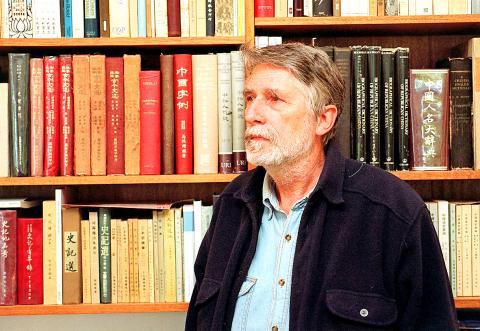Pierre Ryckmans, a Belgian-born scholar of China who challenged a romanticized Western view of former Chinese leader Mao Zedong (毛澤東) in the 1960s with his early portrayal of Mao’s Cultural Revolution as chaotic and destructive, died on Monday last week at his home in Sydney, Australia. He was 78.
His daughter, Jeanne Ryckmans, said the cause was cancer.
Ryckmans, who was better known by his pen name, Simon Leys, fell in love with China at the age of 19 while touring the country with fellow Belgian students in 1955.

Photo: AFP
One highlight was an audience with then-Chinese prime minister Zhou Enlai (周恩來). The man-made famine of Mao’s Great Leap Forward and his Cultural Revolution, which began in 1966 and ended about the time of Mao’s death, in 1976, were still in the future. There was much to be admired in the new China.
Yet pursuing his studies of Chinese art, culture and literature in the People’s Republic of China itself was not an option for a Westerner, so he settled in Taiwan, where he met his future wife, Chang Han-fang. He also lived in Singapore and Hong Kong.
It was in Hong Kong during the late 1960s that Ryckmans began to follow the turmoil just across the frontier, reading accounts in the official Chinese press about the Cultural Revolution and talking to former Mao supporters who had escaped it.
He began to find that the romantic view of Mao harbored by many Western intellectuals — as a progressive if flawed champion of the masses — was completely at odds with the cruelties of the Cultural Revolution, which sought to eradicate Chinese cultural traditions and Western capitalist influences and replace it with a Maoist orthodoxy. The movement led to purges, forced internal exiles and whipsaw shifts in the political winds, and it compelled Ryckmans to step into the arena of political commentary.
“Until 1966 Chinese politics did not loom large in my preoccupations, and I confidently extended to the Maoist regime the same sympathy I felt for all things Chinese, without giving it more specific thought,” Ryckmans wrote under his pseudonym in Chinese Shadows, which was first published in French in 1974.
“But the Cultural Revolution, which I observed from beginning to end from the vantage point of Hong Kong, forced me out of this comfortable ignorance,” he wrote.
His first account, The Chairman’s New Clothes, was also published in French, in 1971, a year after he had settled in Australia to teach at Australian National University. Ryckmans wrote the book under the name Simon Leys to disguise his identity so that he would not be banned from China.
He returned to China in 1972 on a six-month assignment as a cultural attache for the Belgian embassy in Beijing. The wanton destruction of the city’s ancient architectural heritage shocked him.
In Chinese Shadows, he wrote of his frantic search for some of the most magnificent of the city’s huge gates, which he assumed had been preserved, even though he knew that the city walls had been taken apart starting in the 1950s. The gates were gone.
“The destruction of the gates of Peking is, properly speaking, a sacrilege; and what makes it dramatic is not that the authorities had them pulled down but that they remain unable to understand why they pulled them down,” he wrote.
The Cultural Revolution, he found, had destroyed the beauty of Chinese culture and civilization without destroying what needed to be exorcised: the tyranny of arbitrary rule.
In a telephone interview, former Australian prime minister Kevin Rudd, a former student of Ryckmans, called him “the first of the Western Sinologists of the ’60s and ’70s to expose the truth of the cultural desecration that occurred during the Cultural Revolution, ripping away the political veneer from it all and exposing it for what it was: an ugly, violent, internal political struggle within the Chinese Communist Party led by Mao.”
Ryckmans was a frequent contributor to The New York Review of Books, Le Monde and other periodicals and the recipient of several literary prizes.

Kehinde Sanni spends his days smoothing out dents and repainting scratched bumpers in a modest autobody shop in Lagos. He has never left Nigeria, yet he speaks glowingly of Burkina Faso military leader Ibrahim Traore. “Nigeria needs someone like Ibrahim Traore of Burkina Faso. He is doing well for his country,” Sanni said. His admiration is shaped by a steady stream of viral videos, memes and social media posts — many misleading or outright false — portraying Traore as a fearless reformer who defied Western powers and reclaimed his country’s dignity. The Burkinabe strongman swept into power following a coup in September 2022

‘FRAGMENTING’: British politics have for a long time been dominated by the Labor Party and the Tories, but polls suggest that Reform now poses a significant challenge Hard-right upstarts Reform UK snatched a parliamentary seat from British Prime Minister Keir Starmer’s Labor Party yesterday in local elections that dealt a blow to the UK’s two establishment parties. Reform, led by anti-immigrant firebrand Nigel Farage, won the by-election in Runcorn and Helsby in northwest England by just six votes, as it picked up gains in other localities, including one mayoralty. The group’s strong showing continues momentum it built up at last year’s general election and appears to confirm a trend that the UK is entering an era of multi-party politics. “For the movement, for the party it’s a very, very big

ENTERTAINMENT: Rio officials have a history of organizing massive concerts on Copacabana Beach, with Madonna’s show drawing about 1.6 million fans last year Lady Gaga on Saturday night gave a free concert in front of 2 million fans who poured onto Copacabana Beach in Rio de Janeiro for the biggest show of her career. “Tonight, we’re making history... Thank you for making history with me,” Lady Gaga told a screaming crowd. The Mother Monster, as she is known, started the show at about 10:10pm local time with her 2011 song Bloody Mary. Cries of joy rose from the tightly packed fans who sang and danced shoulder-to-shoulder on the vast stretch of sand. Concert organizers said 2.1 million people attended the show. Lady Gaga

SUPPORT: The Australian prime minister promised to back Kyiv against Russia’s invasion, saying: ‘That’s my government’s position. It was yesterday. It still is’ Left-leaning Australian Prime Minister Anthony Albanese yesterday basked in his landslide election win, promising a “disciplined, orderly” government to confront cost-of-living pain and tariff turmoil. People clapped as the 62-year-old and his fiancee, Jodie Haydon, who visited his old inner Sydney haunt, Cafe Italia, surrounded by a crowd of jostling photographers and journalists. Albanese’s Labor Party is on course to win at least 83 seats in the 150-member parliament, partial results showed. Opposition leader Peter Dutton’s conservative Liberal-National coalition had just 38 seats, and other parties 12. Another 17 seats were still in doubt. “We will be a disciplined, orderly